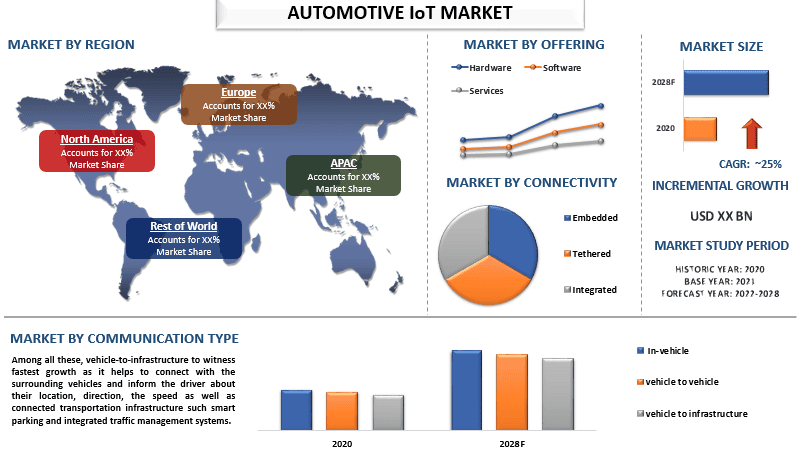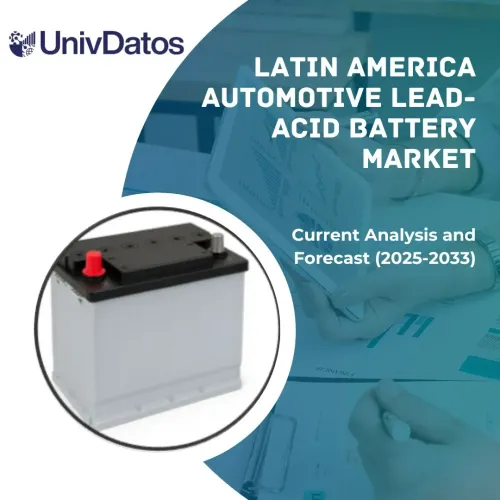- Home
- About Us
- Industry
- Services
- Reading
- Contact Us
Automotive IoT Market: Current Analysis and Forecast (2022-2028)
Emphasis on Offering (Hardware, Software, and Services); Communication Type (In-Vehicle, Vehicle to Vehicle, and Vehicle to Infrastructure); Connectivity (Embedded, Tethered, and Integrated); and Region/Country

Global Automotive IoT Market is expected to grow at a significant rate of around 25% during the forecast period. The Internet of Things (IoT) technology makes it possible to connect various items in a space using both wired and wireless connections. Additionally, an automotive IoT aids in controlling the functions of the car to prevent accidents and lighten the strain on the driver. Additionally, this enables sophisticated components like electronics, actuators, and sensors to communicate with one another and with other online-connected vehicles. The market is expanding because of factors like the rising demand for connected automobiles, government initiatives for smart traffic system management, and rising consumer awareness of road vehicle safety. Some of the market players are advancing technology to obtain lucrative growth in the IoT market. For instance, in February 2022, Ashok Leyland, an India-based automotive manufacturer partnered with Syncron, a Sweden-based after-sales service provider, to integrate predictive vehicle maintenance solutions into Ashok Leyland Condition Monitoring Systems (CMS).
Texas Instruments Incorporated, Intel Corporation, NXP Semiconductors N.V., TomTom N.V., Robert Bosch GmbH, Google LLC, Apple Inc, The General Motors Company, Audi AG, Ford Motor. are some of the key players in the market. Several M&As along with partnerships have been undertaken by these players to facilitate customers with hi-tech and innovative products/technologies.
Insights Presented in the Report
“Amongst offering, software category to witness robust CAGR during the forecast period”
Based on the offering, the market is segmented into hardware, software, and services. The software category to witness higher CAGR during the forecast period owing to the growing demand for advanced and hi-tech vehicles. Moreover, the safety concern of the passenger and the growing advancement of the technologies to adopt the software-based systems coupled with the growing demand for smart parking and automated driving is driving the growth of the market.
“Amongst communication type, the vehicle-to-infrastructure to witness significant growth during the forecast period”
Based on communication type, the market is categorized into in-vehicle, vehicle-to-vehicle, and vehicle-to-infrastructure. Among all these, vehicle-to-infrastructure to witness significant growth during the forecast period owing to the increase in developments related to autonomous vehicles, in conjunction with advancements in 5G technology will create new opportunities for this market. Companies operating in the market are focusing on new product development. For instance, in January 2020, Qualcomm Technologies Inc. introduced a new Qualcomm C-V2X reference platform for vehicular and roadside units (RSUs).
“During 2022-2028, APAC to witness highest incremental growth”
APAC to witness highest incremental growth during the forecast period. In recent years, this region has emerged as a hub for automobile production. The increasing purchasing power of the population and increasing concerns over the environment have triggered the demand for V2X in Asia Pacific. Moreover, the growing concerns about the number of fatal road accidents and the injuries caused by these road accidents have led the government to mandate advance safety features in automobiles. Furthermore, the automotive industry is undergoing a drastic shift, and OEMs are increasingly diverting their attention towards advanced mobility such as connected and autonomous cars. For instance, In August 2021, Hyundai Motor (South Korea) formed a strategic partnership with Autotalks through a direct investment to accelerate the development and deployment of the next-generation chipset for connected cars. This technology would improve vehicle and road safety and mobility, which is important for autonomous driving.
Reasons to buy this report:
- The study includes market sizing and forecasting analysis validated by authenticated key industry experts.
- The report presents a quick review of overall industry performance at one glance.
- The report covers an in-depth analysis of prominent industry peers with a primary focus on key business financials, product portfolio, expansion strategies, and recent developments.
- Detailed examination of drivers, restraints, key trends, and opportunities prevailing in the industry.
- The study comprehensively covers the market across different segments.
- Deep dive regional level analysis of the industry.
Customization Options:
The global automotive IoT market can further be customized as per the requirement or any other market segment. Besides this, UMI understands that you may have your own business needs, hence feel free to connect with us to get a report that completely suits your requirements.
Table of Content
Research Methodology for the Automotive IoT Market Analysis (2022-2028)
Analyzing the historical market, estimating the current market, and forecasting the future market of the global automotive IoT market were the three major steps undertaken to create and analyze the adoption of automotive IoT in major regions globally. Exhaustive secondary research was conducted to collect the historical market numbers and estimate the current market size. Secondly, to validate these insights, numerous findings and assumptions were taken into consideration. Moreover, exhaustive primary interviews were also conducted, with industry experts across the value chain of the global automotive IoT market. Post assumption and validation of market numbers through primary interviews, we employed a top-down/bottom-up approach to forecasting the complete market size. Thereafter, market breakdown and data triangulation methods were adopted to estimate and analyze the market size of segments and sub-segments of the industry pertains to. Detailed methodology is explained below:
Seek More Details About Research Methodology
Analysis of Historical Market Size
Step 1: In-Depth Study of Secondary Sources:
Detail secondary study was conducted to obtain the historical market size of the automotive IoT market through company internal sources such as annual reports & financial statements, performance presentations, press releases, etc., and external sources including journals, news & articles, government publications, competitor publications, sector reports, third-party database, and other credible publications.
Step 2: Market Segmentation:
After obtaining the historical market size of the automotive IoT market, we conducted a detailed secondary analysis to gather historical market insights and share for different segments & sub-segments for major regions. Major segments are included in the report as an offering, communication type, component, connectivity, application, and end-users. Further country-level analyses were conducted to evaluate the overall adoption of testing models in that region.
Step 3: Factor Analysis:
After acquiring the historical market size of different segments and sub-segments, we conducted a detailed factor analysis to estimate the current market size of the automotive IoT market. Further, we conducted factor analysis using dependent and independent variables such as offering, communication type, component, and connectivity of automotive IoT. A thorough analysis was conducted for demand and supply-side scenarios considering top partnerships, mergers and acquisitions, business expansion, and product launches in the automotive IoT market sector across the globe.
Current Market Size Estimate & Forecast
Current Market Sizing: Based on actionable insights from the above 3 steps, we arrived at the current market size, key players in the global automotive IoT market, and market shares of the segments. All the required percentage shares split, and market breakdowns were determined using the above-mentioned secondary approach and were verified through primary interviews.
Estimation & Forecasting: For market estimation and forecast, weights were assigned to different factors including drivers & trends, restraints, and opportunities available for the stakeholders. After analyzing these factors, relevant forecasting techniques i.e., the top-down/bottom-up approach were applied to arrive at the market forecast for 2028 for different segments and sub-segments across the major markets globally. The research methodology adopted to estimate the market size encompasses:
- The industry’s market size, in terms of revenue (USD) and the adoption rate of the automotive IoT market across the major markets domestically
- All percentage shares, splits, and breakdowns of market segments and sub-segments
- Key players in the global automotive IoT market in terms of products offered. Also, the growth strategies adopted by these players to compete in the fast-growing market
Market Size and Share Validation
Primary Research: In-depth interviews were conducted with the Key Opinion Leaders (KOLs) including Top Level Executives (CXO/VPs, Sales Head, Marketing Head, Operational Head, Regional Head, Country Head, etc.) across major regions. Primary research findings were then summarized, and statistical analysis was performed to prove the stated hypothesis. Inputs from primary research were consolidated with secondary findings, hence turning information into actionable insights.
Split of Primary Participants in Different Regions

Market Engineering
The data triangulation technique was employed to complete the overall market estimation and to arrive at precise statistical numbers for each segment and sub-segment of the global automotive IoT market. Data was split into several segments & sub-segments post studying various parameters and trends in the areas of offering, communication type, component, and connectivity, application, and end-users in the global automotive IoT market.
The main objective of the Global Automotive IoT Market Study
The current & future market trends of the global automotive IoT market were pinpointed in the study. Investors can gain strategic insights to base their discretion for investments on the qualitative and quantitative analysis performed in the study. Current and future market trends determined the overall attractiveness of the market at a regional level, providing a platform for the industrial participant to exploit the untapped market to benefit from a first-mover advantage. Other quantitative goals of the studies include:
- Analyze the current and forecast market size of the automotive IoT market in terms of value (USD). Also, analyze the current and forecast market size of different segments and sub-segments
- Segments in the study include areas of offering, communication type, component, and connectivity.
- Define and analysis of the regulatory framework for the automotive IoT
- Analyze the value chain involved with the presence of various intermediaries, along with analyzing customer and competitor behaviors of the industry.
- Analyze the current and forecast market size of the automotive IoT market for the major region.
- Major countries of regions studied in the report include Asia Pacific, Europe, North America, and the Rest of the World.
- Company profiles of the automotive IoT market and the growth strategies adopted by the market players to sustain in the fast-growing market
- Deep dive regional level analysis of the industry
Related Reports
Customers who bought this item also bought










